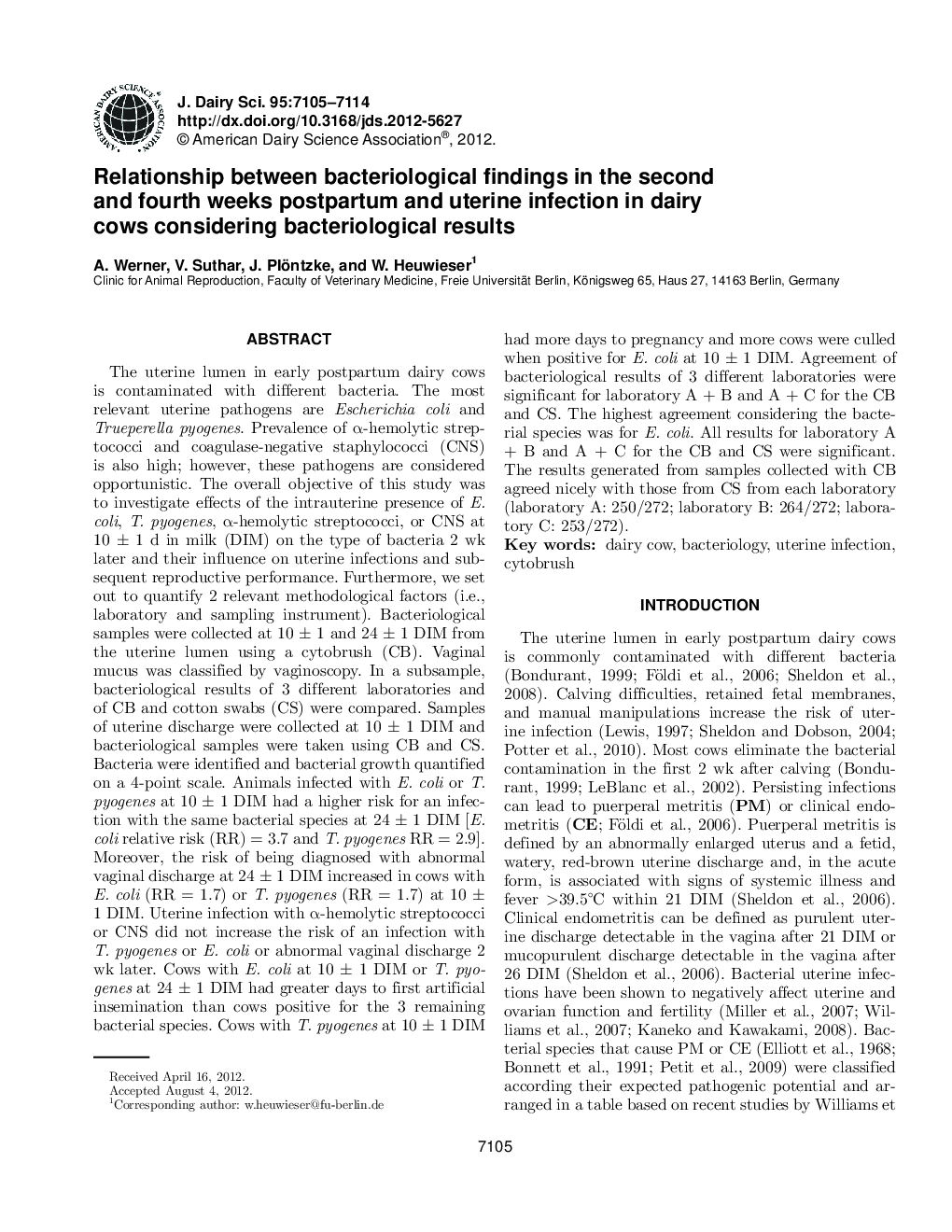| کد مقاله | کد نشریه | سال انتشار | مقاله انگلیسی | نسخه تمام متن |
|---|---|---|---|---|
| 10978665 | 1108059 | 2012 | 10 صفحه PDF | دانلود رایگان |
عنوان انگلیسی مقاله ISI
Relationship between bacteriological findings in the second and fourth weeks postpartum and uterine infection in dairy cows considering bacteriological results
دانلود مقاله + سفارش ترجمه
دانلود مقاله ISI انگلیسی
رایگان برای ایرانیان
کلمات کلیدی
موضوعات مرتبط
علوم زیستی و بیوفناوری
علوم کشاورزی و بیولوژیک
علوم دامی و جانورشناسی
پیش نمایش صفحه اول مقاله

چکیده انگلیسی
The uterine lumen in early postpartum dairy cows is contaminated with different bacteria. The most relevant uterine pathogens are Escherichia coli and Trueperella pyogenes. Prevalence of α-hemolytic streptococci and coagulase-negative staphylococci (CNS) is also high; however, these pathogens are considered opportunistic. The overall objective of this study was to investigate effects of the intrauterine presence of E. coli, T. pyogenes, α-hemolytic streptococci, or CNS at 10 ± 1 d in milk (DIM) on the type of bacteria 2 wk later and their influence on uterine infections and subsequent reproductive performance. Furthermore, we set out to quantify 2 relevant methodological factors (i.e., laboratory and sampling instrument). Bacteriological samples were collected at 10 ± 1 and 24 ± 1 DIM from the uterine lumen using a cytobrush (CB). Vaginal mucus was classified by vaginoscopy. In a subsample, bacteriological results of 3 different laboratories and of CB and cotton swabs (CS) were compared. Samples of uterine discharge were collected at 10 ± 1 DIM and bacteriological samples were taken using CB and CS. Bacteria were identified and bacterial growth quantified on a 4-point scale. Animals infected with E. coli or T. pyogenes at 10 ± 1 DIM had a higher risk for an infection with the same bacterial species at 24 ± 1 DIM [E. coli relative risk (RR) = 3.7 and T. pyogenes RR = 2.9]. Moreover, the risk of being diagnosed with abnormal vaginal discharge at 24 ± 1 DIM increased in cows with E. coli (RR = 1.7) or T. pyogenes (RR = 1.7) at 10 ± 1 DIM. Uterine infection with α-hemolytic streptococci or CNS did not increase the risk of an infection with T. pyogenes or E. coli or abnormal vaginal discharge 2 wk later. Cows with E. coli at 10 ± 1 DIM or T. pyogenes at 24 ± 1 DIM had greater days to first artificial insemination than cows positive for the 3 remaining bacterial species. Cows with T. pyogenes at 10 ± 1 DIM had more days to pregnancy and more cows were culled when positive for E. coli at 10 ± 1 DIM. Agreement of bacteriological results of 3 different laboratories were significant for laboratory A + B and A + C for the CB and CS. The highest agreement considering the bacterial species was for E. coli. All results for laboratory A + B and A + C for the CB and CS were significant. The results generated from samples collected with CB agreed nicely with those from CS from each laboratory (laboratory A: 250/272; laboratory B: 264/272; laboratory C: 253/272).
ناشر
Database: Elsevier - ScienceDirect (ساینس دایرکت)
Journal: Journal of Dairy Science - Volume 95, Issue 12, December 2012, Pages 7105-7114
Journal: Journal of Dairy Science - Volume 95, Issue 12, December 2012, Pages 7105-7114
نویسندگان
A. Werner, V. Suthar, J. Plöntzke, W. Heuwieser,